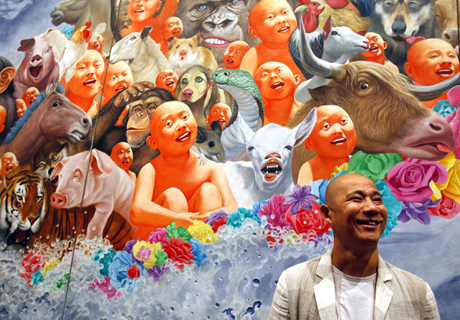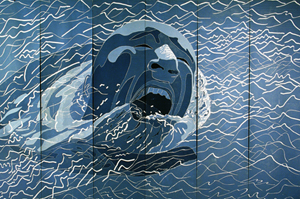Life and Leisure
A bald truth
By Zhu Linyong (China Daily)
Updated: 2010-09-03 16:43
 |
Large Medium Small |
|
 Fang Lijun, one of the hottest contemporary Chinese artists, stages a comprehensive solo exhibition at Today Art Museum in Beijing. Zhang Wei / China Daily
|
Feisty avant-garde artist, Fang Lijun, insists his works merely mirror the situation on the ground and dismisses criticisms he is peddling an image of 'ugly Chinese' Zhu Linyong reports
Fang Lijun is well aware of his reputation as one of the nation's most envied as well as hated avant-garde artists. The 47 year old drives deluxe sedans, breeds bulldogs, runs two restaurant chains and hotels, and has spacious studios in Beijing and in southwestern Yunnan province.
His works sell for millions of dollars at international auctions, and some are in the collections of prestigious museums such as the Pompidou Center in Paris and the Museum of Modern Art in New York.
But he is often accused of churning out repetitive works "to cater to Western collectors" and of presenting an ugly picture of the Chinese in his unorthodox paintings, installations, prints and sculptures.
"People have a number of negative views about me," Fang says. "That is understandable as most know me only through the news and scholarly essays which are often, if not always, misleading and confusing."
To correct this image Fang is, besides his newly published autobiography To Live Like a Wild Dog, staging an exhibition at Today Art Museum "to reveal the stories behind each of my well-known works".
On until Sept 8, the exhibition will display a range of his works - from brightly colored massive paintings, small-sized prints, installations, and sculptures, to photographs, manuscripts, documents, videos, early ink works and pencil sketches - chronicling his evolving artistic life.
|
 Fang Lijun is a versatile artist who has tried out a wide variety of media such as oil, print, sculpture and installation. |
One of Fang's best-known motifs is the stereotypical, disenfranchised bald youth - said to represent farmers.
But it has now come to symbolize a generation rendered as bored simpletons by the paralyzing extremism of a rapidly transforming Chinese society, according to Fang, "where individuals are virtually faceless and nameless."
A defining feature of his works is swirls of clouds, in an intense cobalt blue, permeating water, babies, flowers, and insects.
The artist often manipulates perspective by juxtaposing the sharp focus in the immediate foreground with clouds filling the far distance.
The beautiful serenity of the fragile, ethereal, and chromatically unreal flowers, for example, belie the loss of perspective.
This kind of painting is a metaphor for disorientation and a lack of direction, Fang explains in his new book.
Most of the prints, paintings and installations on show are deliberately unnamed, "to leave viewers more room to use their imagination and their personal memories," Fang says.
One huge diptych painting depicts a band of Fang's trademark baldheads, animals and insects in the story of Noah's Ark.
Another shows a baldheaded youth from behind, wearing a crown of disgusting insects.
One installation features sleeping babies in transparent, plastic balls; another presents a large drinking barrel run through with various tubes, in reference to the heart and its arteries.
Some recent works on display depart from the style of his earlier works. However, their themes seem to connect with his continued efforts to capture a world adrift, of a people lost in space and time.
"I want to show the public that my works do not come from nowhere. The changing social reality has exerted an impact on my worldview and my art," says the artist.
"I live by my heart. And my works reflect my personal history and my perception of the human condition today."
Like many youths of his generation, Fang lived through the tumultuous years of the "cultural revolution"(1966-76), the downfall of the Gang of Four, the early years of the opening- up and reform, and the recent surge of consumerism and materialism.
"Every individual is precious and has his or her value on this earth. Everyone's life is unique," Fang says.
In his view, art is more about one's inner growth than about theory and technique.
"That may explain why artists of my generation came from the same social background, received a similar education, learned the same skills but ended up using different approaches to art."
Fang insists the world is not as perfect or beautiful as it seems.
Reacting to criticisms that he indulges in creating a sense of disillusionment, boredom, cynicism, and absurdity, Fang says: "My art is closely associated with the current condition of Chinese society. It is an honest mirror of social malaise."
Born in 1963 in Handan, Hebei province to a humble family, Fang learned the hard way that he had a rich grandfather - a man whose lands were nationalized when New China was founded.
In 1966, the "cultural revolution" erupted across the country and intellectuals, "counter-revolutionaries" or relatives of capitalists and one-time landowners were denounced.
Fang remembers that as a child, he was told his family had a problematic background.
From an early age, he had to cope with a world where "social and political currents changed almost overnight; and where human nature often turned brutal".
"I was shocked by all this," he says. "In some ways, you had two thoughts in your head. One was that your family was bad; the other was the warmth you felt toward them."
Fang's father, a railroad engineer, was dispatched to the countryside for his "reform" and Fang once joined a denunciation session, only to discover that the man being slammed was his own grandfather.
Schools were closed, boys went fishing, or engaged in petty thievery, and when they played games, Fang always lost, because the other boys insisted he was a loser.
"'You can't win'," he says they would tell him. "'You come from a bad family'."
He learned early to play by the rules of the game: to taunt, to make fun, to appear to be in a crowd, even if he wasn't with it.
Strangely, it was all this that opened the door to his art.
Fang says his father worried about him getting into trouble, and so bought the young boy art supplies, and also hired an art teacher.
In the years that followed, Fang took classes in fine art and sought apprenticeships with various local teachers.
After the "cultural revolution", Fang went on to study ceramics at Hebei Light Industry Technical College, Tangshan, Hebei province.
After graduation, he got a job at an advertising agency, but soon grew bored and left to strike out on his own.
He tried opening his own advertising agency, but spent much of his time doing odd jobs, like construction work.
Life became increasingly difficult and he decided to go back to school
Eventually, he enrolled at the Central Academy of Fine Arts, in 1985, just as the Beijing art scene began to blossom with the 1985 New Wave Art movement.
After graduation, Fang joined the Yuanmingyuan Artists village, a bohemian artistic community on the outskirts of Beijing.
It was here that he forged his style of painting that came to be known as "Cynical Realism."
Looking back, Fang admits he has a bittersweet feeling toward the label Cynical Realism attached to his art by influential critics such as Li Xianting.
"It is like a double-edge sword, on the one hand giving me wealth and fame but on the other, burying the original motivations of my work."
While Fang refuses to link his art with politics, this link is inevitably made when he is introduced to Western viewers and collectors.
"I have never deliberately revealed politics or China's reality in my works. I just try to express my feelings," he argues.
Asked why he clings to his trademark icons such as baldheads and babies instead of trying something different, Fang says: "It is not easy for a vanguard artist to come up with a new icon. And any artist is entitled to exploit his or her creations
"For me, art and business have no problem sitting on the same bench."